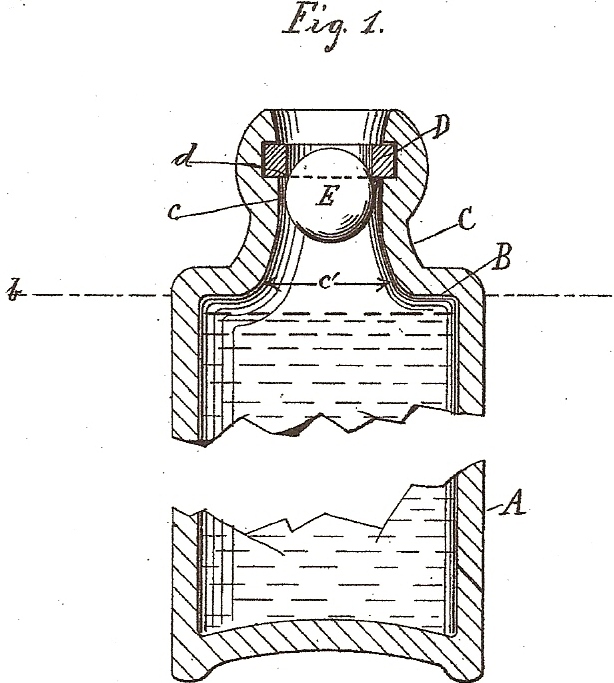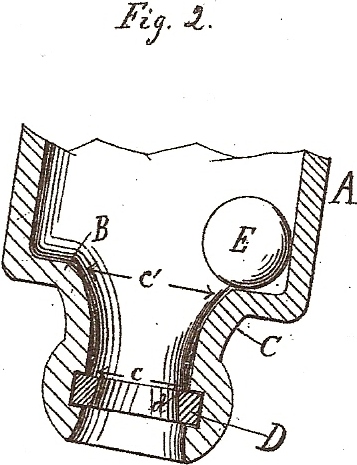Frederic R. H. Thomas Internal Ball Valve Bottle


Frederic
R. H. Thomas’ patent application was filed March 18, 1892 and specified:
I, Frederic R. H. Thomas…of Catskill…
My improvement relates to bottles having, interiorly,
ball-valves closing against seats in the neck of the bottle by the
outward pressure of the gas contained in the bottled liquid – such as
the carbonic-acid gas of ordinary “soda-water,” so called, ginger-ale,
&c. In relation to the
ball-valves used such bottles may be divided in two classes – those
having heavy or sinking valves and those having light or floating
valves. In order to prevent
the valve of the former class from rolling to its seat and shutting off
the flow when pouring out the liquid, the bottles are provided in the
neck or in the side near to the bottom with pockets formed in the
molding, to receive and retain the ball-valve while emptying.
Beside the inconvenience of manipulating the bottle so that the
ball will reach and lodge into one of the said pockets, the pockets
gather dirt and gum, which not only causes the ball to stick there when
not wanted, but makes cleaning difficult and tedious.
Moreover, the location of the valve-seat too far below the mouth
of the bottle makes the valve inconvenient of access in opening and the
long, narrow cylindrical, or too slightly conical neck makes it
necessary to use special means, beside the fingers, to push the ball so
far down as to prevent its being pushed back toward the seat by the
outward rush of the liquid impelled by the gas-pressure.
In bottles having floating ball-valves and improved by
having no pockets another objection exists – namely, that the very light
ball jumps back to its seat time and again when opening, thereby causing
the gas-charged liquid to spatter over the person who opens it, and
sometimes it lodges on the foam and is slow to recede from the neck even
though the bottle be inverted.
Again at times when after emptying a small portion of the liquid
remains, the sweet or gummy ingredients therein will cause the light
ball to adhere to the inner surface of the bottle so hard as to impede
considerably the process of washing.
The usual length of the necks of bottles of both
classes makes them all very liable to be broken.
In those having sinking ball-valves and pockets at the bottom the
bottle must be held upright until the ball has lodged in the said
resting-place. In the
meantime the liquid foams out of the bottle without getting into the
drinking-glass and is wasted.
If the bottle is inclined before the ball has thus lodged, the
ball immediately rolls into the neck and stops the flow of the liquid.
The valve-seat of the ring in the bottle-neck, as heretofore
constructed, has unnecessarily large surface, requiring proportionately
too high pressure to tighten the valve and requiring larger depression
to remove it from its seat in opening.
In order to obviate the aforesaid objections, my
improvement comprises a bottle whose breast forms a square shoulder at
the junction of the body and neck, of a depth not less than the
semi-diameter of the ball, to form a retaining-ledge, a very short
downwardly abruptly flaring or widening neck, narrowest at its upper
end, where it meets the square cut groove, and of a length substantially
the same as its width at the said narrowest point, as shown in the
drawings, and a valve-ring seated in a groove so as to project therefrom,
presenting a sharp edge for contact with the valve and located so near
to the mouth of the bottle as to bring the ball within, say, one-fourth
of one inch below the same, and thus easily accessible to be depressed
by the thumb to drop from its seat when desired to empty the bottle…
Figure 1 represents a bottle embodying my improvements
and in upright position with valve closed.
Fig. 2 shows the same inverted and with valve open as when just
emptied…
In opening the valve drops instantly, there being
plenty of space between the valve and the inner surface of the neck for
the liquid to pass without carrying the valve with it, and the contents
are never spattered. The
extra shortness of the neck saves breakage and the bottle is much easier
cleaned than bottles heretofore used for gaseous beverages…After filling
the bottle the ball will take its seat upon the ring
D quickly, thereby saving
largely in gas, gas-water, flavor, &c., otherwise spilled and wasted.
The valve-seat is formed by a rubber ring
D, inserted in a groove in the
bottle-neck, as usual, but the seat proper is not beveled, the hole in
the ring being cylindrical, as in Fig. 1, or tapering inward, as in Fig.
2, in either case leaving a sharp corner or annular edge d to receive
and seat the ball-valve. The
ball is of the heavy or sinking kind.
Comments:
This interesting patent is included in this overview
because Thomas’ specifications detail many of the challenges bottlers
and customers experienced with both heavy and light ball-stoppered
bottles. Although Thomas’
bottles are sometimes confused with
 HutchBook.com
HutchBook.com